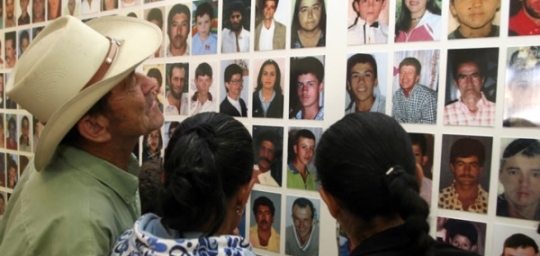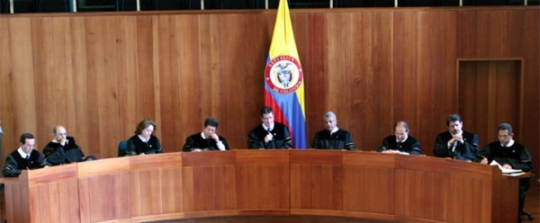Strategic Challenges of the Justice and Peace Law
Address by Pablo de Greiff, Director of ICTJ’s Research Unit
This brief address is for the occasion of the conference to be held on August 24, “Selection or Prioritization as a Strategy for Prosecuting International Crimes?” The issue is absolutely crucial: six years after the enactment of Law 975 of 2005, the “Justice and Peace” Law, under President Uribe’s initiative, Colombia has found—as many other countries that have tried to confront legacies of massive human rights abuses—that criminal justice measures, however important they may be in a transitional process, cannot be the only answer to its sad legacy.
Positive outcomes: victims’ visibility and capacity
I am not suggesting this attempt has not brought positive outcomes and that the efforts have all been in vain. Like many others, I would first like to emphasize the visibility of victims of Colombia’s armed conflict, that has had an effect on, as well as resulted from, these processes: just a couple of years ago the armed conflict was talked about only as a threat to the country’s economic infrastructure, ignoring the suffering of many forgotten victims.

Hall of Never More Granada (Antioquia), victims of paramilitaries.
Second, the learning curve about transitional justice processes has been quite steep in Colombia. In only a couple of years, the term has become known and has been included in discussions among experts, but even more importantly, in civil society, including the media, as well as in the vocabulary used in the drafting of legislation. Although some uses of the term do not seem right to me—a subject to which I will return—there is no doubt an increased general awareness of the status of victims exists, and, therefore, this awareness extends to all citizens as rights bearers, which is one of the main purposes of a transitional justice policy.
Third, the process has had a significant effect—related to the two mentioned here above—in the articulation of civil society groups advocating for citizens’ rights, and in the dismantling of other groups that undermine them, although as we know, this process remains far from complete.
Finally, there is no denying that state and non-state institutions have increased their capacities and skills to address the legacies of massive human rights abuses that have occurred in the country in the past decades.
Where criminal justice falls short
Despite the irreversible importance, in my opinion, of some of these advances, the concrete and direct results of the Justice and Peace Law implementation are quite disappointing until this day: four partial sentences, thousands of processes barely started, and a similar number not yet started; copious information about crimes not yet analyzed in a systematic way, keeping the country from having a comprehensive view of how violence is carried out, and especially the systemic connections between armed groups and different local, regional, and national powers; the beginnings of reparation and restitution processes that have been tiring for victims as well as for institutions responsible for victims; and, the element lagging the most, weak, erratic, and disjointed institutional reforms.
There are various factors underlying these problems: from the beginning, mistakes were made regarding the design of the proposed processes; the political will of several actors responsible for the design and implementation of various initiatives has not always been exemplary; and, as always, in the competition between justice and other purposes, justice has not always been victorious.
The Justice and Peace process: flaws in design
Among the design flaws, there are two that I find important to note. The first is quite general. In Colombia, transitional justice instruments have not been used as elements of a transitional process, especially for peace, but rather as substitutions for peace agreements. The previous government bragged about the uniqueness of the Colombian process, without ever mentioning these substitutions. A crucial error. Although the various transitional justice measures can contribute extensively to the consolidation of peace, it is not clear that they have been designed to construct peace by themselves.
The second design flaw is that the whole institutional framework of transitional justice favored—in fact was—dependent, on judicial processes. This is ironic given that nothing suggested the judicial system could easily take on this new task—a task already particularly difficult for more developed judicial systems with greater resources and support.

The Supreme Court of Justice, Colombia.
The issue here goes far beyond questions of effectiveness. Even if the system had been capable of absorbing the immense burden it was assigned, the point of the transitional justice process is not only to assign blame (in the legal sense) when it comes to solving legacies of systematic and mass violence, but to foster a sense of responsibility for the violations, which obviously goes far beyond the issue of criminal responsibility.
In addition to these factors, there is another that aggravated the situation: the delay in developing an investigation policy centered on the systemic character of the crimes in question. Although the development of such a policy is welcome, its manifestations are not yet obvious, and its effects are not clear in the selection of cases that could show the nature of the criminal apparatus and of the factors that fuel impunity.
Addressing these challenges
This conference is a great opportunity to directly address these challenges. There is no doubt the aspiration to prosecute each and every one of Colombia’s human rights violations—an aspiration no country that has suffered widespread violence has successfully achieved—would be easier to reach with a criminal prosecution strategy that concentrates its efforts and resources, instead of treating every crime as a separate, unrelated crime.
And although it is not the central theme of the conference, my hope is it contributes to strengthening the idea that even with a sensitive judicial policy, other components of transitional justice, namely clarification, reparation in a broad sense, and institutional reform, especially of the security sector, are as important as the judicial component and must work as part of an integrated policy.
Although the judicial path to redeem rights is obviously an important part of a system based in the rule of law, there is no effective path in which their redemption depends exclusively on judicial processes. These are usually the last, not the first resort. This brings us to a point where, in Colombia, people can stop thinking of transitional justice as an odd type of justice, rather, as a way to give right-respecting regimes a way to protect the fundamental rights of their citizens.
